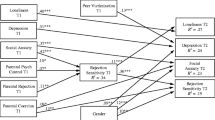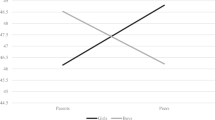Abstract
Rejection sensitivity (RS) is the disposition to defensively expect, perceive and over-react to perceived rejection by others. RS has been theorized to originate from early attachment. However, this hypothesized link remains untested. This study aims to examine the relationship between attachment security and rejection sensitivity in early adolescence. Eight-graders (N = 406) completed self-report measures of attachment security and rejection sensitivity. Attachment security to father and mother were found to be associated. Attachment dimensions-trust and alienation from mother were significant predictors of RS in the adolescents. Alienation from mother mediated the link between alienation from father and RS in the adolescents. The two forms of RS- anxious RS and angry RS were predicted by different dimensions of attachment to mother.
Similar content being viewed by others
References
Allen, J. P., Moore, C., Kuperminc, G., & Bell, K. (1998). Attachment and adolescent psychosocial functioning. Child Development, 69, 1406–1416.
Armsden, G. C., & Greenberg, M. T. (1987). The inventory of parent and peer attachment: Relationships to well-being in adolescence. Journal of Youth and Adolescence, 16(5), 427–454.
Armsden, G. C., & Greenberg, M. T. (1998). The inventory of parent and peer attachment. Journal of Youth and Adolescence, 16(5), 427–453.
Aseltine, R. H., Jr. (1995). A reconsideration of parental and peer influences on adolescent deviance. Journal of Health Social Behavior, 36(2), 103–121.
Baumeister, R., & Leary, M. (1995). The need to belong: Desire for interpersonal attachments as a fundamental human motivation. Psychological Bulletin, 117, 497–529.
Bowlby, J. (1973). Attachment and loss: Vol. 2. Separation: Anxiety and anger. New York: Basic Books.
Bowlby, J. (1980). Attachment and loss: Vol. 3. Loss, sadness and depression. New York: Basic Books.
Bowlby, J. (1988). A secure base: Clinical implications of attachment theory. London: Routledge and Kegan Paul.
Chekki, D. A. (1988). Recent directions in family research: India and North America. Journal of Comparative Family Studies, 19, 171–186.
Chitra, S. (2002). Caretaker interaction and socio-emotional behavior in early childhood. In A. Shah & K. Rao (Eds.), 2007, Psychological research in mental health & neuro sciences (pp. 1957–2007). Bangalore: NIMAHNS.
Dhruvarajan, V. (1990). Religious ideology, Hindu women and development in India. Journal of Social Issues, 46, 57–69.
Downey, G. (1998). Rejection sensitivity and children’s interpersonal difficulties. Child Development, 69(4), 1074–1091.
Downey, G., & Feldman, S. (1996). Implications of rejection sensitivity for intimate relationships. Journal of Personality and Social Psychology, 70, 1327–1343.
Downey, G., Feldman, S., Khuri, J., & Friedman, S. (1994). Maltreatment and child depression. In W. M. Reynolds & H. E. Johnson (Eds.), Handbook of depression in childhood and adolescence (pp. 481–508). New York: Plenum.
Engels, R. C. M. E., Finkenauer, C., Meeus, W., & Dekovic, M. (2001). Parental attachment and adolescents’ emotional adjustment: The associations with social skills and relational competence. Journal of Counseling Psychology, 48, 428–439.
Erikson, E. (1950). Childhood and Society. New York: Norton.
Erozkan, A. (2004). Rejection, vulnerability, cognitive appraisal and coping in romantic relationships. Unpublished PhD Dissertation, Institute of Social Sciences, Karadeniz Technical University, Trabzon, Turkey.
Feldman, S., & Downey, G. (1994). Rejection sensitivity as a mediator of the impact of childhood exposure to family violence on adult attachment behavior. Development and Psychopathology, 6, 231–247.
Fox, N. A., Kimmerly, N. L., & Schafer, W. D. (1991). Attachment to mother/attachment to father: A meta-analysis. Child Development, 62, 210–222.
Havinghurst, R.J. (1953). Human development and education. Cited from Lieberman M. Doyle AB, Markiewiez D (1999). Developmental pattern in security of attachment to mother and father in late childhood and early adolescence. Child Development, 70(1) 202–213.
Homey, K. (1937). The neurotic personality of our time. New York: Norton.
Kakar, S. (1992). The inner world. New Delhi: Oxford University Press.
Kayastha, P., Hirisave, U., Natarajan, G., & Goyal, G. (2010). Security of attachment in children and adolescents—An Indian experience. Asian Journal of Psychiatry, 3, 173–176.
Kerns, K. A., & Stevens, A. C. (1997). Parent-Child attachment in the late adolescence: Links to social relations and personality. Journal of Youth and Adolescence, 25, 323–342.
Kerns, K. A., Tomich, P. L., Aspelmeier, J. E., & Contreras, J. M. (2000). Attachment based assessment of parent–child relationships in middle childhood. Developmental Psychology, 36(5), 614–626.
Kobak, R. R., & Sceery, A. (1988). Attachment in late adolescence: Working models, affect regulation, representations of self and others. Child Develpoment, 59, 135–146.
Kurtz, S. N. (1992). All the mothers are one: Hindu India and the cultural reshaping of psychoanalysis. New York: Columbia University Press.
Lieberman, M., Doyle, A. B., & Markiewiez, D. (1999). Developmental pattern in security of attachment to mother and father in late childhood and early adolescence. Child Development, 70(1), 202–213.
London, B., Downey, G., Bonica, C., & Paltin, I. (2007). Social causes and consequences of rejection sensitivity in adolescents. Journal of Research on Adolescence.
Maslow, A. (1987). Motivation and personality (3rd ed.). New York: Harper & Row.
McClelland, D. C. (1987). Human motivation. Cambridge: Cambridge University Press.
Narayanan G, Rao K, Kapur M. (2002). Attachment styles, personality and coping in young adults. M. Phil (Clinical Psychology) Dissertation, Bangalore: National Institute of Mental Health and Neurosciences.
Natarajan,G., Downey,G., Sundaram, K.R., Somasumdaram, C.P., Reddy, K.S & Rainer Romero-Canyas, R. (2010). Rejection sensitivity mediates the link between attachment insecurity and maladjustment in early adolescence. Poster presented at the Annual Conference of Association of Psychological Studies, Boston.
Nithya Poornima, M., Chitra, S., & Hirisave, U. (2005). Attachment, temperament and social behavior in early childhood. Indian Journal of Clinical Psychology, 32, 91–97.
Papini, R. (1991). Early adolescent perceptions of attachment to mother and father. Journal of Early Adolescence, 11(258–275).
Rogers, C. (1959). A theory of therapy, personality, and interpersonal relationships, as developed in the client-centered framework. In S. Koch (Ed.), Psychology. A study of a science, vol. 3 (pp. 184–226). New York: McGraw-Hill.
Roopnarine, J. L., & Hossain, Z. (1992). Parent-child interactions in urban Indian families in New Delhi: Are they changing? In J. L. Roopnarine & D. B. Carter (Eds.), Parent-child socialization in diverse cultures (pp. 1–16). Norwood: Ablex.
Roopnarine, J. L., & Suppal, P. (2000). Kakar’s psychoanalytic interpretation of Indian cildhood: The need emphasize the father and multiple caregivers in the socialization equation. International Journal of Group Tensions, 29(3/4), 349–370.
Sharma, D. (1998). Child care in India: A comparative view of infant social environments. In D. Sharma & K. Fischer (Eds.), Socioemotional development across cultures. New directions in child development (pp. 45–67). San Francisco: Jossey-Bass.
Shek, D. T., Lee, B. M., Lee, T. Y., & Lam, C. M. (2006). Frequency, satisfaction and quality dimensions of perceived parent-adolescent communication among Chinese adolescents in Hong Kong. International Journal of Adolescent Medicine and Health, 18(2), 259–270.
Shukla, A. (1987). Decision making in single- and dual-career families in India. Journal of Marriage and the Family, 49, 621–629.
Smith, C., & Krohn, M. D. (1995). Delinquency and family life among male adolescents: The role of ethnicity. Journal of Youth and Adolescence, 24, 69–93.
Steele, M., Steele, H., & Fonagy, P. (1996). Associations amongst attachment classifications of mothers, fathers and their infants. Child Development, 67, 541–555.
Sullivan, H. S. (1937). A note on the implications of psychiatry, the study of interpersonal relations, for investigation in the social sciences. The American Journal of Sociology, 43, 157–164.
Suppal, P., Roopnarine, J. L., Buesig, T., & Bennett, A. (1996). Ideological beliefs about family practices: Contemporary perspectives among north Indian families. International Journal of Psychology, 31, 29–37.
Vishwanatha, K., & Hirisave, U. (2008). Attachment and psychopathology in children with emotional disorders. Indian Journal of Pediatrics, 75(4), 395–397.
Zahn-Waxler, C. (2000). The development of empathy, guilt, and internalization of distress. In R. Davidson (Ed.), Wisconsin symposium on emotion: Vol. I. Anxiety, depression, and emotion (pp. 222–265). New York: Oxford University Press.
Acknowledgment
The authors thank Prof. Geraldine Downey, Rainer Romero-Canyas, and Kavita Reddy for their valuable inputs on rejection sensitivity, when the first author was a Fulbright fellow at the Social Relations Lab, Department of Psychology, Columbia University, New York, USA.
Author information
Authors and Affiliations
Corresponding author
Rights and permissions
About this article
Cite this article
Natarajan, G., Somasundaram, C.P. & Sundaram, K.R. Relationship between Attachment Security and Rejection Sensitivity in Early Adolescence. Psychol Stud 56, 378–386 (2011). https://doi.org/10.1007/s12646-011-0108-8
Received:
Accepted:
Published:
Issue Date:
DOI: https://doi.org/10.1007/s12646-011-0108-8




